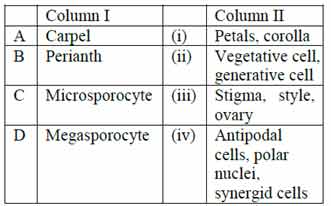Dear Students,
Welcome to CSIR NET Botany Question Paper. This MCQ set consists of AdvancedBotany / Plant Science Multiple Choice Questions taken from the previous year question papers of CSIR NET Life Sciences Examination. These questions can be used for the preparation of CSIR NET, ICMR JRF, DBT BET JRF, GATE and other University Ph.D Entrance Examinations.
You may also like: Botany Notes | Botany PPT
(1). Among the following statements, which is the correct one that refers to a Holotype? (CSIR_2017_II)
(a). Specimens collected from different locations and designated as type specimens by the author
(b). A single specimen or illustration upon which name is based and designated as nomenclature type by the author
(c). Specimens collected from different places and designated as type specimen
(d). A single specimen designated to serve as nomenclatural type when all of the materials on which the name of the taxon was based is missing
Ans. (b)
(2). Which one of the following statements is true about xylem in plants? (CSIR_2017_II)
(a). It is characterized by the presence of tracheary elements responsible for the conduction of water in vascular plants
(b). It is responsible for the transport of water and characterized by sieve elements like parenchyma cells and sclereids
(c). It is responsible for the transport of assimilates in the vascular plants and characterized by tracheary elements.
(d). It is responsible for the transport of assimilates in both vascular and nonvascular plants
Ans. (a)
(3). Identify the plant species from which artemisinin, an anti-malarial drug, is extracted. (CSIR_2017_II)
(a). Artemisia maritima
(b). Artemisia scoparia
(c). Artemisia annua
(d). Cinchona officinalis
Ans. (c)
(4). Euphorbiaceae generally represents milky sap bearing plants but there are also some non-milky sap bearing plants that belong to this family. Identify the correct combination of the following given plants which belong to family Euphorbiaceae. (CSIR_2017_II)
(a). Terminalia bellirica, Euphorbia hirta, Nerium indicum
(b). Mallotus philippense, Ficus religiosa, Ricinus communis
(c). Mallotus philippense, Acalypha indica, Emblica officinalis
(d). Acalypha indica, Ricinus communis, Mangifera indica
Ans. (c)
(5). Given below are statements on key characteristics of two fungal lineages.
(A) Microsporidia do not have true mitochondria
(B) Most chytrids produce flagellated gametes
(C) Microsporidia are usually free-living
(D) Chytrids reproduce sexually without a dikaryon stage
Choose the combination with correct statements (CSIR_2017_II)
(a). A, B and C only
(b). A, B and D only
(c). B, C and D only
(d). A and B only
Ans. (b)
(6). Match the two columns that represent plant organs (I) and parts within these organs (II). (CSIR_2017_II)
(a). A-(i); B-(iii); C-(ii); D-(iv)
(b). A-(iii); B-(iv); C-(i); D-(ii)
(c). A-(i); B-(iii); C-(iv); D-(ii)
(d). A-(iii); B-(i); C-(ii); D-(iv)
Ans. (d)
(7). The amount of each enzyme present in the chloroplast stroma is regulated by mechanisms that control the concerned expression of nuclear and chloroplast genomes. Following are certain statements regarding the regulation of chloroplast enzymes:
(A). Nucleus-encoded enzymes are translated on 70S ribosomes in the cytosol and subsequently transported into the plastid
(B). Plastid encoded enzymes are translocated in the stroma on prokaryotes-like 70S ribosomes
(C). Light modulates the expression of stromal enzymes encoded by the nuclear genome via specific photoreceptors.
(D). The eight small subunits of RUBISCO is encoded in plastid
Which one of the following combinations of above statements is correct? (CSIR_2015_I)
(a). (A) and (B)
(b). (A) and (C)
(c). (B) and (C)
(d). (C) and (D)
Ans. (c)
(8). In terpene biosynthesis pathways, three acetyl-CoA are joined together stepwise to form mevalonic acid. Which one of the following three steps is required by mevalonic acid to form isopentenyl diphosphate or isopentenyl pyrophosphate (IPP)? (CSIR_2015_I)
(a). Pyrophosphorylation, decarboxylation and dehydration
(b). Alkylation, Pyrophosphorylation and decarboxylation
(c). Methylation, dehydration and alkylation
(d). Phosphorylation, carboxylation and methylation
Ans. (a)
(9). Gibberellic acid (GA) controls seed germination by directing breakdown of the stored starch. In which one of the following tissues of the barley seed, α-amylase gene is induced in response to GA? (CSIR_2015_II)
(a). Endosperm
(b). Coleoptile
(c). Aleurone layer
(d). Embryo
Ans. (c)
(10). Which one of the following is NOT a phenotype of dark-grown seedlings that are etiolated? (CSIR_2017_II)
(a). Short hypocotyls
(b). An apical hook
(c). Closed cotyledons
(d). Non-photosynthetic proplastids
Ans. (a)

